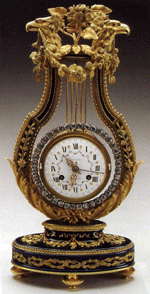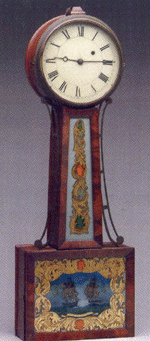|
Recognizing The Many Styles & Names of Clocks
By Anne Gilbert
As any clock collector will tell you, clocks do more than just keep time.
They can entertain you as well. Their names can be just as entertaining with
mystery clocks, blinking-eye clocks and wag-on-the-wall, to mention just a few.
As for entertainment, how about a clock with the figure of Napoleon on top that
walks back and forth and in and out of his tent? Or, consider the blinking-eye
clock. The eyes connected to the escarpment or a human or animal figure move
with each unlocking of the lever. The mystery clock lives up to its name. The
works are completely hidden, and it appears to work "mysteriously", often with
human figures that move without apparent impulse. Wall clocks resembling the
shape of a banjo, and so named, were first made by Simon Willard, circa 1802.
During the reign of Louis XVI, the elegance of clock making reached its
peak. The most precious materials were used to frame the clock face. This
included tortoiseshell with brass inlay and horn mounts or lacquer combined with
bronze. It became fashionable for clocks to be used within pieces of furniture.
The great ebenistes of the era made desks, cabinets and over mantels with
inset clocks.
Always one of the most beautiful and expensive mantel clocks is
the Louis XVI lyre clock with "garniture". The lyre form was topped with a gilt
bronze or ormolu "sun king." Paste brilliants encircled the dial. The garniture
consisted usually of matching urns.
By the late 19th century, there were
many makers of clocks including Tiffany and Co. Their turn-of-the-century mantel
clocks were designed to match the interior fashions of the times. For example,
when the Japanese influence on design was in vogue, Tiffany and Co. sold a
three-piece gilt-bronze and cloisonné enamel clock and garniture. The pieces
were decorated with Japanese symbols of bats, cranes and crabs.
Also very
popular at the time were gilt-bronze mantel clocks with figures of poets and
Caesar reclining on a marble base. They tied in with the then trendy bronze
sculptures.
Clocks made during the Art Nouveau, Arts and Crafts and Deco
eras, and the more recent 1950s, also reflected designs, motifs and materials of
their decades. Many cases were designed by a famous artist or an important
porcelain maker. For example, Limoges made a few porcelain pieces in the Art
Nouveau style. Even Rene Lalique created a frosted glass clock with
intaglio-molded female figures in the Art Deco style.
Art Deco examples
combined unusual materials as copper, rock quartz, chromed metal and Bakelite on
mantel clocks.
CLUES: Reproductions of the Louis XV and XVI have never
stopped being made. They can sell at auction for $10,000 or more. Banjo clocks
have been reproduced since their introduction.
It is never too late to begin
a clock collection. Interesting and affordable examples can turn up anywhere.
Or, subscribe to various auction catalogs to get a feel for what's
happening.

|

Lyre form French mantel clock. (All photos, Julia Auctions, Fairfield , ME.)

Willard-type banjo clock. |